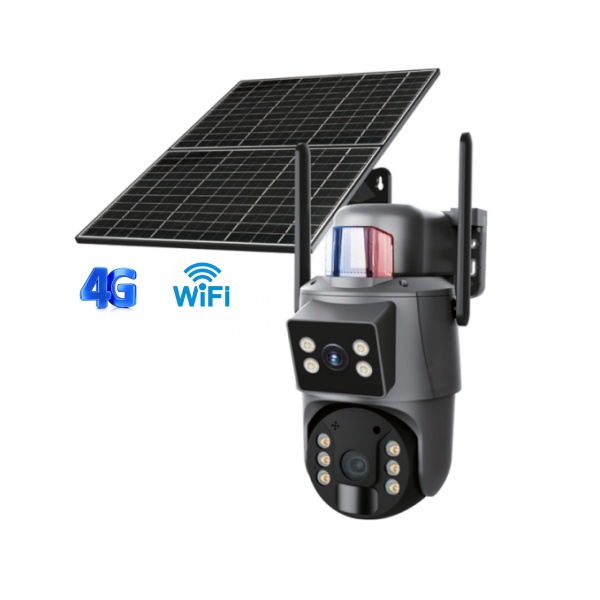Your Next Product Line: The Future of Solar Security Cameras is AI-Powered
For over a decade, the solar security camera market has solved a fundamental problem: providing surveillance where power cables can’t reach. From remote construction sites to sprawling farms, these devices offer invaluable flexibility. Yet, as a B2B partner—whether you’re a brand, an installer, or a distributor—you know the single biggest complaint from end-users: the flood of false alarms.
Every notification triggered by a swaying tree branch, a passing animal, or even a sudden change in lighting erodes user trust. This “notification fatigue” turns a proactive security tool into a passive, often ignored, one. For your business, this translates to customer dissatisfaction, increased support tickets, and a tarnished brand reputation. The era of simple motion detection is over. The future, and your next bestselling product line, lies in AI-powered intelligence.
Artificial Intelligence is not a buzzword; it’s a core engineering solution that transforms a solar camera from a simple motion sensor into a smart, discerning guard. It’s the critical upgrade that addresses the primary pain point of your customers and provides a clear, marketable advantage.
How AI Redefines Solar Camera Intelligence
When we talk about an “AI camera,” we’re specifically referring to on-device (or “edge”) AI processing. Unlike cloud-based systems that upload vast amounts of video for analysis, an AI-powered solar camera uses its internal chipset to analyze footage in real-time, right on the device itself. This is a critical distinction for off-grid solutions.
The process is elegantly efficient:
- Capture: The camera’s sensor captures motion, just like a traditional camera.
- Analyze: Instead of immediately sending an alert, the onboard AI algorithm analyzes the moving object’s characteristics. It asks: “Is this a person? A vehicle? Or just a stray cat?”
- Decide: Based on its analysis and the user’s pre-set rules (e.g., “only alert for humans”), the camera decides whether the event is significant.
- Act: Only if the event is deemed significant does the camera trigger an alert, start recording to the cloud, or activate a siren.
This on-device approach is fundamental for solar-powered units. It drastically reduces unnecessary data transmission over 4G networks and minimizes power consumption by preventing the camera from waking up and recording for every irrelevant event. This directly impacts two key resources: battery life and data costs, a crucial selling point for your customers.
Core Analysis: Traditional Motion Detection vs. AI-Powered Detection
For your clients, understanding the tangible benefits of AI is key to recognizing the value of upgrading their product offerings. The difference isn’t incremental; it’s transformative. Here’s a direct comparison of the technologies.
| Feature | Traditional PIR/Motion Detection Camera | AI-Powered Solar Security Camera |
|---|---|---|
| Alert Accuracy | Low. Triggers on any motion (animals, shadows, rain, insects), leading to over 90% false alarms. | Extremely High. Differentiates between humans, vehicles, and other objects, reducing false alarms by up to 95%. |
| Battery & Data Use | High. Wakes up and transmits data for every motion event, rapidly draining the battery and consuming 4G data plans. | Optimized. Processes on-device and only wakes/transmits for relevant events, significantly extending battery life and saving data costs. |
| Video Search Efficiency | Inefficient. Users must manually scrub through hours of footage triggered by irrelevant motion to find a specific event. | Highly Efficient. Users can filter recordings by “human” or “vehicle,” locating critical moments in seconds. |
| Security Value | Reactive. Informs you that *something* happened, but provides little context and high noise. | Proactive. Provides actionable intelligence, allowing users to respond to genuine threats while ignoring distractions. |
Case Study: Securing a High-Value Construction Site
A clear example of AI’s impact comes from one of our partners who works with construction contractors.
Problem: A large commercial building site was using traditional 4G solar cameras to monitor valuable equipment and materials. The site manager was receiving over 200 notifications per night from flapping tarps, wildlife, and passing car headlights. His team became desensitized to the alerts, and the constant video uploads were maxing out their monthly data plan.
Solution: We provided them with our next-generation AI-powered 4G solar cameras. We helped them configure virtual perimeters (geofencing) and set the detection rules to “Human & Vehicle Detection Only” during non-working hours. Any other motion was ignored.
Result: The results were immediate and quantifiable.
- 98% Reduction in False Alerts: The manager now only receives 3-5 meaningful alerts per night, allowing for an immediate response.
- 70% Reduction in Data Usage: By eliminating unnecessary uploads, the project stayed well within its data budget.
- Averted Theft: Two weeks after installation, the system detected a person breaching the perimeter at 2 a.m. and sent an instant alert. The manager was able to activate the camera’s siren and notify authorities, preventing the theft of copper wiring valued at over $15,000.
This is the powerful story you can tell your customers. AI doesn’t just add a feature; it delivers a tangible return on investment.
Market Trends: What’s Next for AI in Security?
The current implementation of human and vehicle detection is just the beginning. As a product developer or brand owner, it’s crucial to understand where this technology is heading to plan your future roadmap.
1. Advanced Behavioral Analytics: Soon, cameras will move beyond simple object identification. They will recognize behaviors like loitering detection (someone lingering near a vehicle for too long), package delivery/theft, and fall detection for elder care applications.
2. Sound Recognition: AI will be able to identify specific sounds, such as breaking glass, smoke alarms, or even gunshots, and trigger alerts accordingly. This adds another layer of contextual awareness.
3. Predictive Security: By analyzing patterns over time, AI systems will be able to predict potential threats. For example, a vehicle that repeatedly circles a block late at night could be flagged as suspicious before any crime is committed.
For your business, this evolution means a move from selling a single hardware product to offering a comprehensive security solution, potentially with recurring revenue streams for advanced analytics and monitoring services.
Sourcing Checklist: How to Choose Your AI Solar Camera Manufacturing Partner
Not all AI cameras are created equal. As you prepare to add AI-powered devices to your portfolio, it’s critical to partner with a factory that has deep engineering expertise. Use this checklist during your evaluation:
- Edge vs. Cloud Processing: Confirm that the AI processing is done on the device (edge) to ensure low power and data consumption. Ask about the specific chipset used and its performance benchmarks.
- Algorithm Maturity: How accurate is the detection algorithm? Ask for data on false positive rates and the types of objects it can reliably identify. A mature algorithm is the result of extensive training and refinement.
- Power Management Integration: The AI system must be deeply integrated with the camera’s Battery Management System (BMS). A sophisticated system will have different AI operating modes to intelligently conserve power. Learn more about why the BMS is a key technology in solar cameras.
- Customization and Flexibility: Can the AI rules be easily customized? Your customers will need the ability to define specific detection zones, schedule rules, and adjust sensitivity.
- API and Integration Support: For your larger clients, like telecom operators or enterprise security firms, the ability to integrate the camera’s AI alerts into their existing software platforms via an API is a non-negotiable requirement.
The Clear Advantage for Your Business
Adopting AI-powered solar security cameras is no longer an option—it’s a strategic necessity for staying competitive. This technology directly solves your customers’ most significant pain point while providing you with a product that has a higher perceived value and stronger profit margins.
By shifting from basic motion detection to intelligent event analysis, you empower your customers with actionable information, not just noise. You offer them peace of mind, efficiency, and a more reliable security system. That is a powerful competitive differentiator.
Ready to lead the market with the next generation of smart, reliable, and efficient solar security solutions? It’s time to offer a product that sees and thinks. Partner with an expert manufacturer that builds intelligence into every device. **Contact the UBOXCAM engineering team today** to discuss our OEM/ODM capabilities for AI-powered wireless outdoor security cameras and secure your sample.

